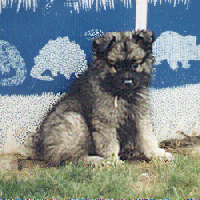that they have not been bred to hunt, kill animals, attack or chase undoubtedly accounts for their gentle, intelligent devotion to their owners as home-loving dogs with a special fondness for children, for which they are renowned.
They are of the same ancestry as the Samoyeds, Huskies, Norwegian Elkhounds and Pomeranians, and apparently came into Europe with voyagers in the 17th and 18th centuries from Holland.
The Keeshond is a loving, outgoing and playful dog, typically very good with children and other animals. Its lovely silver, black and cream, often heavy coat, with its perky curled tail, can make an owner proud. But, like all breeds, one must also understand its special qualities.
The Keeshond is a very people-oriented breed. It needs to be made an integral part of the family and given the attention and affection of a regular family member. It must never be chained outside. Doing so, would break the loving spirit of this wonderful breed.
The Keeshond is also a high energy breed. A large fenced backyard and/or frequent walks are essential for the young dog. I acquired my first Keeshond when he was 9 weeks old. The first 10 months with my Kees was comparable to the first 10 months of raising my daughter. Tireless! They are little clowns. They love to play. It doesn't matter if you're tired and you don't want to play. The Kees will make you play. They will purposely take something they know they are not permitted to have, and run with it, to get you to chase them. Be patient with them. They will outgrow this puppiness. Training with positive reinforcement will result in the perfect companion dog. A Kees does not respond well to physical punishment. One of the best ways to punish a Kees is to seperate him from you, just like a time-out for your kids. Pen him in a seperate room, or crate him for about 15-20 minutes when he won't behave. This works best if he can see you, but can't get to you. Please note that this is my own personal experience in raising Keeshonden. You may find your Kees responds differently than mine.

